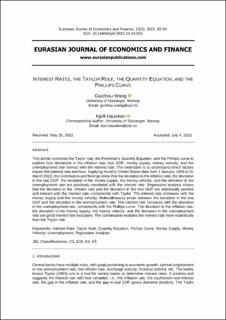| dc.contributor.author | Wang, Guizhou | |
| dc.contributor.author | Hausken, Kjell | |
| dc.date.accessioned | 2023-03-15T15:21:26Z | |
| dc.date.available | 2023-03-15T15:21:26Z | |
| dc.date.created | 2022-07-19T21:52:42Z | |
| dc.date.issued | 2022 | |
| dc.identifier.citation | Wang, G., & Hausken, K. (2022). Interest Rates, the Taylor Rule, the Quantity Equation, and the Phillips Curve. Eurasian Journal of Economics and Finance, 10(3), 83-93. | en_US |
| dc.identifier.uri | https://hdl.handle.net/11250/3058570 | |
| dc.description.abstract | This article combines the Taylor rule, the Friedman’s Quantity Equation, and the Phillips curve to explore how deviations in the inflation rate, real GDP, money supply, money velocity, and the unemployment rate interact with the interest rate. The motivation is to understand which factors impact the interest rate and how. Applying monthly United States data from 1 January 1959 to 31 March 2022, the contribution and findings show that the deviation in the inflation rate, the deviation in the real GDP, the deviation in the money supply, the money velocity, and the deviation in the unemployment rate are positively correlated with the interest rate. Regression analysis shows that the deviation in the inflation rate and the deviation in the real GDP are statistically positive and interact with the interest rate, consistently with Taylor. The interest rate increases with the money supply and the money velocity. Multicollinearity exists between the deviation in the real GDP and the deviation in the unemployment rate. The interest rate increases with the deviation in the unemployment rate, consistently with the Phillips curve. The deviation in the inflation rate, the deviation in the money supply, the money velocity, and the deviation in the unemployment rate are good interest rate indicators. The combination explains the interest rate more realistically than the Taylor rule. | en_US |
| dc.language.iso | eng | en_US |
| dc.publisher | Eurasian Publications | en_US |
| dc.rights | Navngivelse 4.0 Internasjonal | * |
| dc.rights.uri | http://creativecommons.org/licenses/by/4.0/deed.no | * |
| dc.title | Interest Rates, the Taylor Rule, the Quantity Equation, and the Phillips Curve | en_US |
| dc.type | Peer reviewed | en_US |
| dc.type | Journal article | en_US |
| dc.description.version | publishedVersion | en_US |
| dc.rights.holder | The authors | en_US |
| dc.subject.nsi | VDP::Samfunnsvitenskap: 200 | en_US |
| dc.source.pagenumber | 83-93 | en_US |
| dc.source.volume | 10 | en_US |
| dc.source.journal | Eurasian Journal of Economics and Finance (EJEF) | en_US |
| dc.source.issue | 3 | en_US |
| dc.identifier.doi | 10.15604/ejef.2022.10.03.001 | |
| dc.identifier.cristin | 2038824 | |
| cristin.ispublished | true | |
| cristin.fulltext | original | |
| cristin.qualitycode | 1 | |

